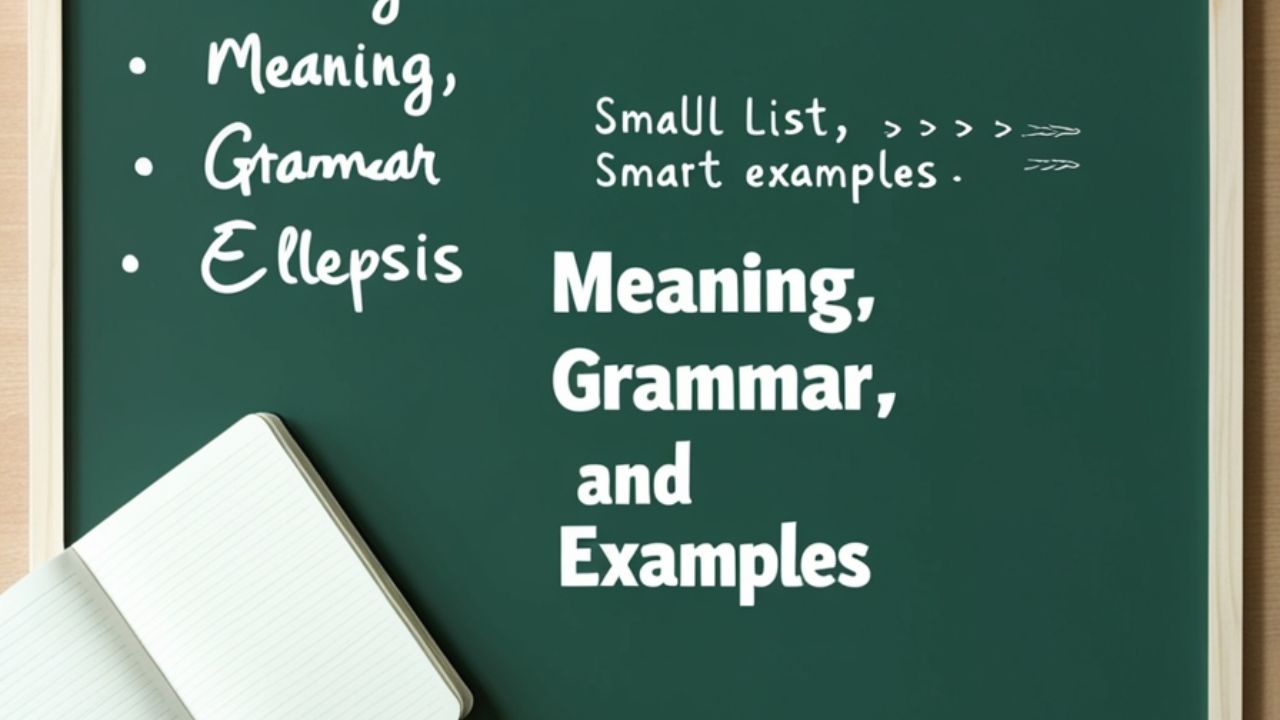The phrase Among Others helps you show a few items from a bigger group. It tells the reader that the list continues. You give key names and keep the sentence short. This phrase adds clarity and supports simple meaning in writing.
Use the phrase as a short prepositional group. Place commas around it when it interrupts a sentence. For clear grammar, write: She worked with Sara and Ali, among others. The commas mark extra information. They guide the reader and improve flow.
Here are smart examples in easy lines. He visited Lahore and Karachi, among others. We studied verbs and nouns, among others. The team thanked coaches and helpers, among others. Each sentence lists a few names and hints at more.
Understanding “Among Others” in Depth
Definition and Purpose
Writers use the phrase among others to show a few names from a bigger group. It signals inclusion without long lists. This clear meaning helps young readers follow ideas. You state key items, then imply more. The phrase keeps sentences tidy and easy.
The purpose supports neat lists and focus. You highlight important examples, then hint at the rest. You place commas before and after the phrase when it interrupts. That choice improves rhythm and clarity. Teachers value this habit in clean, direct writing.
Etymology and Historical Usage
Writers trace the etymology to Middle English. People said “among” to mean in company. They said “others” to mean additional members. Together, among others marked inclusion within a group. Scribes spread the phrase across manuals and chronicles, and students learned its sense.
Editors show its historical usage in law, academia, and newspapers. Authors list key examples, then signal more. Teachers guide commas around the phrase when it interrupts a clause. Careful grammar keeps lines clear, trims long lists, and supports steady reading habits.
Grammatical Function of “Among Others”
What Role It Plays in a Sentence
Use among others as a short prepositional phrase. It works as a modifier that adds extra detail. It never acts as subject or object. Place commas when it interrupts a clause. This grammar choice keeps lists neat and readable for learners.
It fits at the beginning, middle, or end. Start placement widens the group’s scope. Middle placement balances rhythm and emphasis. End placement spotlights the named items. These examples guide clarity and tone. Writers choose the position that suits purpose.
See also : Checkup or Check Up: Key Differences Explained Clearly
Subject, Object, or Modifier?
In a sentence, among others works as a modifier. It adds detail to a noun or clause. It does not serve as subject. It does not serve as object. This grammar role keeps lists short and clear for young readers.
Writers place the phrase near the items it explains. They set commas when it interrupts the main clause. The modifier blends smoothly with names. Clear placement supports clarity and rhythm. Simple examples guide students toward tidy sentences in homework and classwork.
Strategic Use of “Among Others” in Writing

Why Writers Use It
- Writers show a few key names and hint at more with among others. This builds clarity and keeps lists short.
- They maintain smooth flow and readable grammar by avoiding long, heavy catalogs of items.
- They highlight important examples without crowding the sentence, so readers focus on the main ideas.
How to Avoid Overuse
Overusing the phrase can dilute its impact. Use it sparingly to ensure it adds value and clarity to your writing.
Sentence Placement and Positioning
Beginning, Middle, or End?
- Place it at the beginning to set a wide scope early. You signal a group first, then give names. This order supports clarity and calm pacing.
- Put it in the middle to balance rhythm and meaning. Commas guide the pause. Readers track the list with steady flow.
- Use it at the end to spotlight examples. The main idea arrives first, then the list lands with extra emphasis.
Impact of Placement on Tone and Clarity
Placement can subtly shift emphasis. Beginning placement highlights the group’s diversity, while end placement emphasizes the notable examples.
Examples of “Among Others” in Different Sentence Types
- Declarative: State a clear fact. Example: She studied verbs and nouns, among others. This line shows a short list and hints at more. It keeps clarity and simple rhythm.
- Compound: Join two ideas. Example: We visited museums, among others, and we wrote notes. The phrase trims the list and supports smooth flow.
- Complex: Add a dependent clause. Example: While traveling, he saw forts, among others, that inspired sketches. The line highlights key examples without a long list.
Punctuation Rules: Do You Use a Comma Before “Among Others”?
Commas: When, Where, and Why
Use commas to signal extra information around among others. When it interrupts a clause, place a comma before and after it. At the end of a sentence, place one comma before it. These steps support clean grammar, steady rhythm, and easy reading.
Place the words with care for smooth clarity. At the beginning, write the phrase, then add a comma. In the middle, wrap it with two commas. At the end, add one comma before it. These choices strengthen flow and meaning.
Comma Impact on Flow and Emphasis
A comma creates a small pause that guides the reader. The pause shapes sentence flow and keeps ideas tidy. Use it to separate the phrase from the main clause. You support emphasis on key names. You also prevent crowded lists and stumbling.
Placement changes tone and focus. When you set the phrase in the middle, commas cushion it and protect clarity. At the end, one comma gives weight to examples. At the start, a comma sets rhythm and broad meaning for the group.
Common Mistakes and How to Avoid Them
- Missing commas: Writers forget commas around the phrase in the middle. Fix it: We thanked the coaches, among others, after the game. Commas protect clarity and rhythm.
- Wrong role: Writers treat the phrase like a noun. Keep it a modifier. It adds detail only.
- Overuse: Writers repeat it in every line. Use sparingly. Vary with such as, including, or for example to keep smooth flow.
See also : Some of Whom or Some of Who? Grammar Made Simple
Alternatives to “Among Others”

Synonyms and Contextual Substitutes
- Everyday writing uses including, such as, and “and more.” These choices feel simple and friendly. They keep lists short and clear for young readers. Use them when you present a few names from a bigger set.
- Formal contexts prefer inter alia, including but not limited to, and “among other things.” These phrases suit reports, policies, and academic notes. They sound precise and careful. They guide neat structure and steady tone.
- Teaching notes favor for example, for instance, and “notably.” These cues introduce sample items without long catalogs. They help readers see the pattern fast. They also support clean flow in short practice sentences.
Subtle Nuances Between Alternatives
Writers choose among others when they want gentle inclusion. Other alternatives change the shade of meaning. “Including” sounds firm. “Such as” sounds teaching focused. “For example” introduces samples. Each choice shapes clarity and keeps the list short, tidy, and easy for young readers.
Register matters. Legal writers prefer “inter alia” for strong formality. Teachers use “such as” in lessons. Reporters use “including” in short lines. Business teams add “and more” for friendly meaning. Match the phrase to the audience, the goal, and the reading level.
“Among Others” vs. “Among Other”
Understanding the Grammatical Difference
- Use among others to show unnamed members in a group. It stands alone. Write: She thanked the coaches, among others. This form signals more names. It supports clean grammar and short lists.
- Use among other only before a plural noun. It does not stand alone. Write: She thanked the coaches, among other helpers. The noun follows the phrase. This pattern keeps clarity.
- Remember the roles. Among others points to people or things in general. Among other narrows the idea to a category, like things, fields, or reasons. Choose the form that matches your meaning and sentence plan.
Examples Clarifying Usage
- General use: She thanked the coaches and helpers, among others. This shows a short list and hints at more. The line keeps clarity and simple grammar.
- Category use: He studies math and science, among other subjects. The noun follows the phrase. These examples guide neat writing.
- Placement guide: Beginning—Among others, we invited seniors. Middle—We invited seniors, among others, from school. End—We invited seniors, among others. Each choice shapes clarity and tone.
Case Studies: Real-World Use of “Among Others”
Academic Writing
“The study analyzed data from various countries, among others, the USA and Canada.”
Journalism
“The award was presented to several artists, among others, Jane Doe and John Smith.”
Business Reports
“Our clients include multinational corporations, among others, XYZ Corp and ABC Ltd.”
Conclusion
Use among others to keep lists short and clear. You show a few names and signal more without fuss. Good grammar supports young readers. Place commas with care. Keep sentences simple. You build clarity and control tone in every line.
Practice with short lines and neat examples. Try beginning, middle, and end positions. Add one or two commas when needed. Aim for clean meaning and steady rhythm. You guide your reader and strengthen lists. You write with confidence in school tasks.
FAQs
How do you use among others in a sentence?
Use it to show inclusion within a group. Example: “She invited teachers, doctors, and artists, among others.”
Is it correct to say “among others”?
Yes, it’s correct. It means including some people or things but not listing everyone.
What is another word for “among others”?
Alternatives include “including,” “along with,” or “as well as,” depending on sentence structure and tone.
How do you use among other things in a sentence?
Example: “He enjoys hiking and painting, among other things,” meaning those are part of several interests.

Join Bibcia on a journey to master English grammar. Discover easy lessons, writing tips, and practical examples designed to make learning grammar simple and effective.










